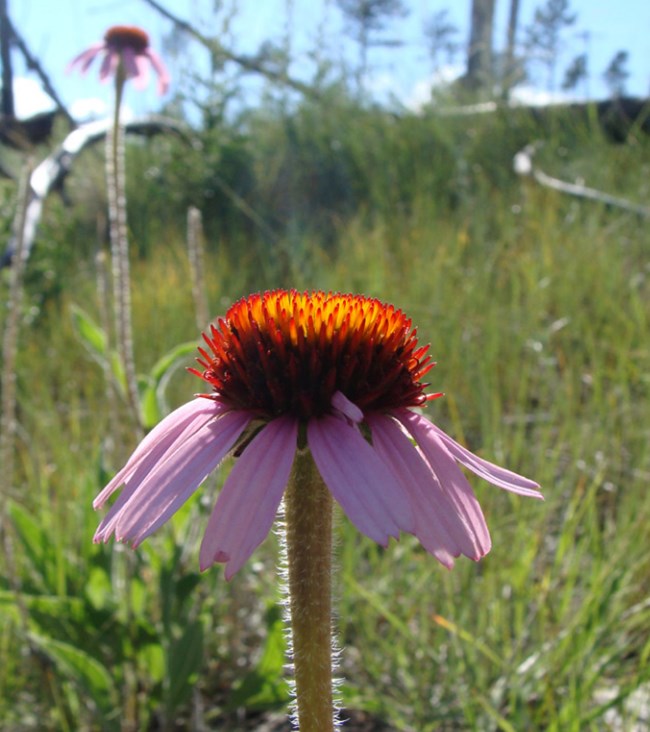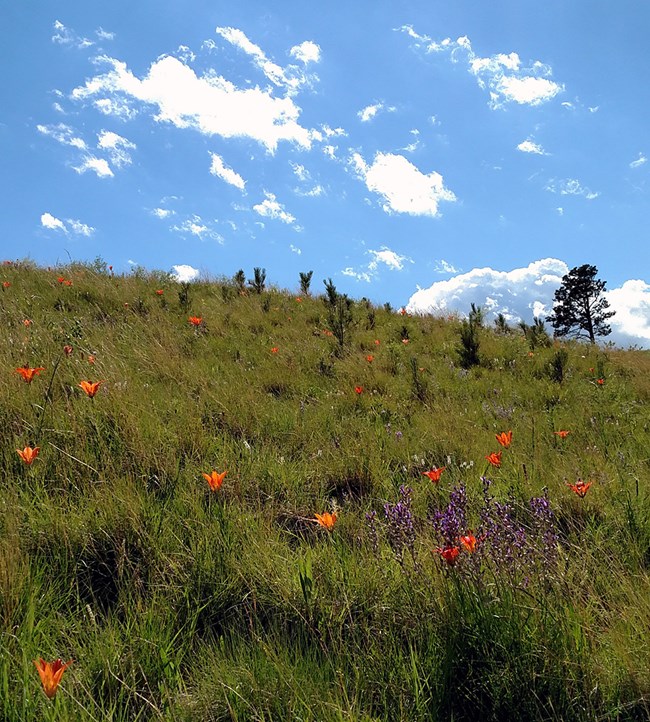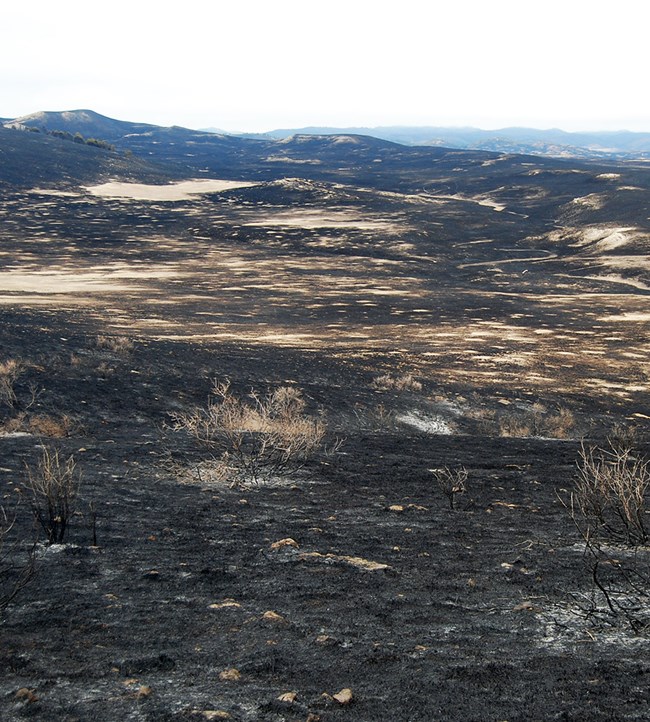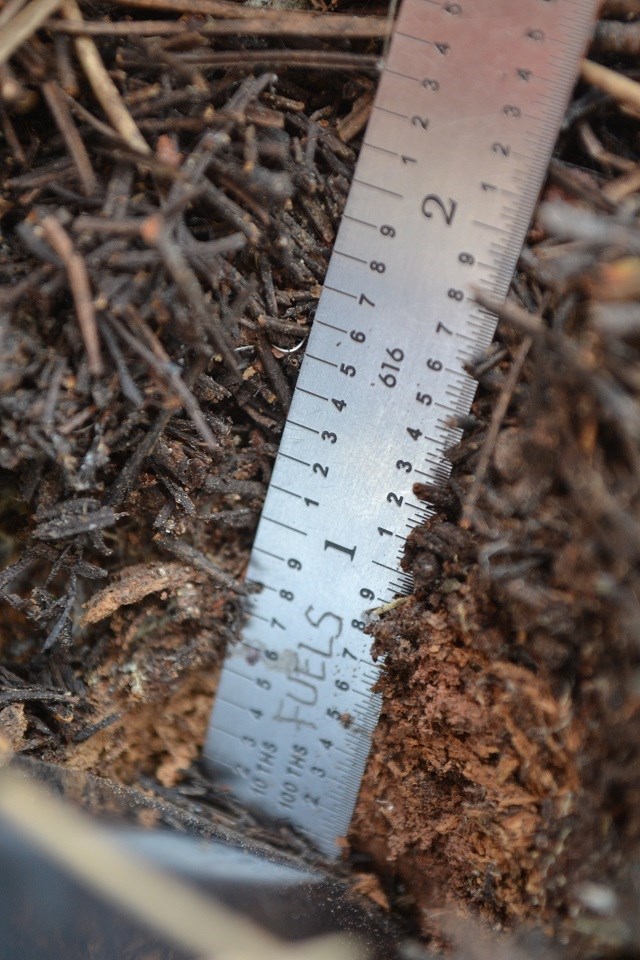Part of a series of articles titled Plant Community Monitoring in Northern Great Plains Network Parks.
Article
Plant Community Monitoring at Wind Cave National Park

NPS
Overview
Wind Cave National Park is known for the amazing and unusual geology of its complex cave system underground, but the park also protects 33,851 acres of ponderosa pine (Pinus ponderosa) forest and mixed-grass prairie with a number of streams and riparian (streamside) plant communities above ground. The park is in the southern Black Hills of western South Dakota. The Black Hills contain about 1.5 million hectares of discontinuous ponderosa pine forest surrounded by the prairies of western South Dakota and eastern Wyoming. This ponderosa pine forest is a unique ecosystem composed of species from the western Rocky Mountains, eastern deciduous forests, northern boreal forests, and surrounding Great Plains.
Plants on the park are sensitive to many stressors, including invasive exotic species, habitat fragmentation, climate change, and altered fire and grazing patterns. Park management actions, such as prescribed fire, exotic species control, and wildlife management, may also affect plant communities. The Northern Great Plains Inventory and Monitoring Network conducts long-term monitoring of plant communities at Wind Cave National Park because it helps us better understand the current health of ecosystems and it can provide an early warning of undesirable changes.

NPS
What We Monitor
The NPS Northern Great Plains Fire Ecology Program began vegetation monitoring on the park in the late 1990s to evaluate the effectiveness of prescribed burns. In 2011, our network began a collaboration with the Fire Ecology Program to continue monitoring plants with revised methods and long-term plots throughout the park, except for along streams, which is a separate effort. A subset of the plots are monitored each year on a rotating basis.
At each plot, we record the native and exotic species found and the vegetation cover of each species, a measure of how much ground is covered by the plants. When woody species are present, tree regeneration and tall shrub density data are collected. We map and tag larger trees and record the status (live or dead) and condition (leaf-discoloration, insect-damaged, etc.) of each tree.
In 2012 and 2017, we surveyed additional forested plots to better understand the status and trends in ponderosa pine forest vegetation specifically. We measured tree stem density, tree diameter, live and dead tree condition, forest fuel loading, cover of exotic species, and disturbance. These plots will continue to be monitored every five years.

NPS
Plant Communities in the Park
The Wind Cave National Park species list includes 589 plants. In 2018, 230 unique plant species were found on monitoring plots, and over 420 species have been found since 1998 when the Fire Ecology Program began plant monitoring. Graminoids (grasses, sedges, and rushes) accounted for most of the vegetation cover, but forbs (flowering plants that are not woody and not a grass or grass-like), shrubs, trees, and vines are also present. The most common graminoids were western wheatgrass (Pascopyrum smithii), little bluestem (Schizachyrium scoparium), threadleaf sedge (Carex filifolia), needle and thread (Hesperostipa comata), and big bluestem (Andropogon gerardii).
Since monitoring was initiated, we have detected 73 exotic species on the park. Exotic grasses are particularly abundant, including Kentucky bluegrass (Poa pratensis), the most common exotic species. Two species are of conservation concern, nylon hedgehog cactus (Echinocerus viridiflorus) and a moonwort species (Botrychium sp.).

NPS
Based on the 2012 and 2017 forest condition plots, the park’s ponderosa pine forests are an outstanding resource with a high diversity of native plants. Overall condition of the forest is good. However, there was an increase in exotic plant species between 2012 and 2017. Also, in some areas of the park, the forests have a high density of trees compared to historical conditions. This is likely a legacy of widespread fire suppression during the last century.
The Legion Lake fire started in December of 2017 after our 2017 forest monitoring. It burned a total of 53,875 acres, 7,000 of which were in the park. We expect to see larger changes in forest densities and seedling recruitment in the future because of this large and intense fire.
More Details
- Plant communities at Wind Cave National Park have a moderate to high number of native plants compared to similar areas nearby.
- There were more native species in grassland plots than in forested plots, but exotic species abundance did not differ between the two.
- The spread of two annual invasive bromes, cheatgrass (Bromus tectorum) and Japanese brome (Bromus japonicas), in the park is a concern because annual brome presence is associated with decreases in native species in the Northern Great Plains.
- Native and exotic species cover did not vary between plots burned recently and plots that had not burned in a while, but annual brome cover was significantly higher in plots that had not burned in over 20 years. Prescribed burning may assist in reducing annual brome cover, but other control methods may also be required.
- There was little change in forest structure between 2012 and 2017, but there were higher frequencies of target exotic species in 2017 in the forests, such as Japanese brome and Canada thistle (Cirsium arvense).

NPS
Did You Know?
Fire is an important component of ponderosa pine forest and mixed-grass prairie ecosystems, and promotes healthy function of both systems while limiting encroachment of ponderosa pine into prairie habitat. Prescribed burning of areas in Wind Cave National Park began in 1973 after fires had been suppressed for much of the previous century. Historically, fires occurred in this area every 10 to 12 years. A changing climate is likely to alter the complex interaction between the ponderosa pine and mixed-grass prairie vegetation communities due to changes to the fire regime (increases in fire frequency, length of fire seasons, and fire severity), which may cause changes to the spatial extent of the forest and mixed-grass prairie throughout Wind Cave National Park and the larger Black Hills area.
For More Information
Visit the Northern Great Plains Network website to read more about plant monitoring at Wind Cave National Park.
Protocol Contact, Northern Great Plains Inventory and Monitoring Network: Isabel Ashton
Summary by Northern Great Plains Network, updated in 2019
Last updated: November 20, 2019
